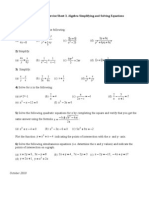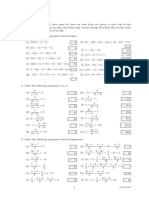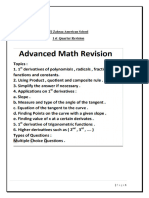0 ratings0% found this document useful (0 votes)
Factrizacin
Factrizacin
Uploaded by
Reik Luiz DiazThe document provides examples of factorizing algebraic expressions. It contains 16 problems where students are asked to factorize expressions involving variables like x, y, a, b into their prime factors. The problems start with simpler expressions involving addition and subtraction and progress to more complex ones involving multiplication, exponents, and multiple variables.
Copyright:
© All Rights Reserved
Available Formats
Download as PDF, TXT or read online from Scribd
Download as pdf or txt
Factrizacin
Factrizacin
Uploaded by
Reik Luiz Diaz0 ratings0% found this document useful (0 votes)
The document provides examples of factorizing algebraic expressions. It contains 16 problems where students are asked to factorize expressions involving variables like x, y, a, b into their prime factors. The problems start with simpler expressions involving addition and subtraction and progress to more complex ones involving multiplication, exponents, and multiple variables.
Original Description:
Factorización
Copyright
© © All Rights Reserved
Available Formats
PDF, TXT or read online from Scribd
Share this document
Did you find this document useful?
Is this content inappropriate?
The document provides examples of factorizing algebraic expressions. It contains 16 problems where students are asked to factorize expressions involving variables like x, y, a, b into their prime factors. The problems start with simpler expressions involving addition and subtraction and progress to more complex ones involving multiplication, exponents, and multiple variables.
Copyright:
© All Rights Reserved
Available Formats
Download as PDF, TXT or read online from Scribd
Download as pdf or txt
0 ratings0% found this document useful (0 votes)
Factrizacin
Factrizacin
Uploaded by
Reik Luiz DiazThe document provides examples of factorizing algebraic expressions. It contains 16 problems where students are asked to factorize expressions involving variables like x, y, a, b into their prime factors. The problems start with simpler expressions involving addition and subtraction and progress to more complex ones involving multiplication, exponents, and multiple variables.
Copyright:
© All Rights Reserved
Available Formats
Download as PDF, TXT or read online from Scribd
Download as pdf or txt
You are on page 1/ 1
ÁLGEBRA
Factorizanción
Nivel Sayajin Nivel Super Sayajin
1. Siendo: P(x)=(x+1)(x–3)(z–1) 10. Factorizar: ax+bx+cx+ay+by+cy–a–b–c
indica el número de factores primos
a) (a+b+c)(x–y) b) (a+b+x)(c–y)
a) 1 b) 2 c) 3 c) (a+b+c)(x–y+1) d) (a+b+c)(x+y)
d) 4 e) 5 e) (a+b+c)(x+y–1)
2. Indica la suma de factores primos de:
2 3 11. Factorizar: ab+7a+8b+56
P(x)=(x–1) (x+1)
2 a) (a+b+1)(a+7) b) (ab+8)(ab+7)
a) 0 b) 1 c) 2x
2 3 c) (a+b+7)(a+b+8) d) (a+7)(b+8)
d) 2x e) x +x
e) (a+8)(b+7)
3. Indica el factor primo que más se repite en: 3
10 8 5 10 12. Factorizar: x –1
P(x)=5 x (x–1) (y+3)
2
a) x(x–1) b) x (x–1)
a) (y+3) b) 5 c) x 2 2
c) (x–1)(x +x+1) d) (x+1)(x –x+1)
d) (x–1) e) 5x 2
e) (x –1)(x+1)
2 3
4. Factorizar: 3x +6x 13. Factorizar: (8x +1)
a) 3x(x+2) b) 2x(x+3) c) x(3x+2) 2 3
a) (8x+1)(x +1) b) 8(x +1)
d) x(6x+3) e) (3x+1)(1+2x) 2 2
c) (2x+1)(4x –2x+1) d) (2x–1)(4x +2x+1)
2
5. Factorizar: mx+m +xy+my
2 e) (8x +1)(x–1)
2 2
a) (x+m)(m+y) b) (x+y)(x+m) 14. Factorizar: P(x;y)=x +2xy+y −25
c) (x+y+m)(x–m) d) (2x+n)(y+2m) e indicar la suma de sus factores primos.
e) (2m+x)(y+2m)
a) 2(x+1) b) 2(y+1)
2
6. Factorizar: ax+x +ab+bx c) 2(x−y) d) 2(x+y)
e) 2x+y
a) (a+x)(x+b) b) (a+x)(ax+b)
c) (a+b)(x+b) d) (a+b+x)(x–b) 15. Factorizar:
e) (a+x)(x+a+b) 2 2 2
P(x;m)=x +2ax+a −m +4m−4
2
indicar un factor primo
7. Factorizar: 4a –9
a) (4a+3)(4a–3) b) (2a–3)(2a+3) a) x+a+m b) x−a+m
2
c) (4a+9)(4a–9) d) a(4a–9) c) x+a +m−2 d) x+a+m−2
2 e) x+2a+m−1
e) a (4–9)
2 2 2 2 2
8. Factorizar: 36x –25y 16. Factorizar: m np+mnp +mn p
2 indicando un factor primo
a) (6x+5y)(6x–5y) b) x (36–25y)
c) y2(36x2–25) d) (36x+5y)(36x–5y) 2
a) m+n+p b) m–n c) m +n
e) (36x+25y)(36x–25y) 2 2
d) m+n e) m –n
4 4
9. Factorizar: 81x −y
indicando un factor primo
a) 9x+y b) 9x−y
2
c) 9x +y 2 d) 3x+y2
e) 3x−y2
Prof: Reik Diaz Reymundo
You might also like
- Antiderivative_and_Initial_Value_Problems_Practice_2010-2011No ratings yetAntiderivative_and_Initial_Value_Problems_Practice_2010-20113 pages
- Algebraic Fractions Worksheet #01, Algebra Revision From GCSE Maths Tutor100% (2)Algebraic Fractions Worksheet #01, Algebra Revision From GCSE Maths Tutor2 pages
- 2 Year (Full Book) : Career Prep EngineeringNo ratings yet2 Year (Full Book) : Career Prep Engineering14 pages
- Basic Integration Questions For PracticeNo ratings yetBasic Integration Questions For Practice14 pages
- MHF Exam Review - MHF4U0-2-Advanced Functions-Lohan, NNo ratings yetMHF Exam Review - MHF4U0-2-Advanced Functions-Lohan, N1 page
- 2020 - 2021, Quadratic Function - 071819No ratings yet2020 - 2021, Quadratic Function - 0718192 pages
- 12th Maths 20-10-24 Aryabhtta Eng Mock PAPERNo ratings yet12th Maths 20-10-24 Aryabhtta Eng Mock PAPER4 pages
- Banco de Problemas de Seleccion Multiple Calculo Integral PDFNo ratings yetBanco de Problemas de Seleccion Multiple Calculo Integral PDF48 pages
- Analytic Geometry: Graphic Solutions Using Matlab LanguageFrom EverandAnalytic Geometry: Graphic Solutions Using Matlab LanguageNo ratings yet



























































